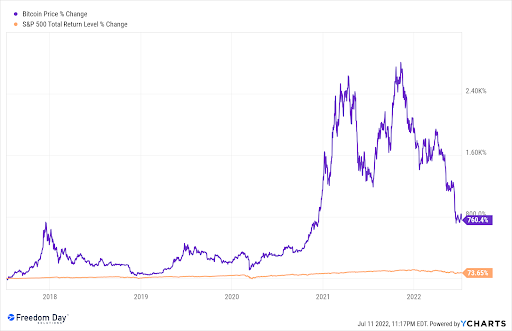Recent headlines about cryptocurrency have highlighted significant declines in price over the last year. In November 2021, bitcoin (BTC) reached an all-time high of more than $68,000, and the current price is hovering around $20,000, a steep drop. The crypto market overall is experiencing significant volatility, and crypto prices have plunged 70% from their all-time highs. Some prominent figures are declaring we're seeing the “death of crypto.” But are we, really? Let's take a look at historical cycles and price movement in order to gain perspective and context and set proper expectations for future price movement.
An overview of crypto and market volatility
Volatility is nothing new for cryptocurrencies and, in fact, should be expected. There have been six periods of significant decline in bitcoin (along with other altcoins) since bitcoin’s inception in 2009.
- June 2011: The price of bitcoin fell 99% from its high
- August 2012: Bitcoin fell 56% from high
- April 2013: Bitcoin fell 83% from high
- December 2013: Bitcoin fell 50% from its high in a period of 24 hours
- December 2018: Bitcoin fell 84% from its high
The early crashes were caused by the market cycles often seen in highly speculative asset classes. The December 2013 crash happened because China banned bitcoin mining, while the 2018 crash came right after the initial coin offering (ICO) craze that ended in many projects failing.
Opinion: Why This Crypto Crash Is Different
When you look at the list above, it does tell the story of a highly volatile, risky asset. But viewed through the wider lens of speculative assets, this volatility is comparable to other growth assets, even some of the largest equities in the world.
Since its initial public offering (IPO) in 1997, the mega-cap stock Amazon (AMZN) has experienced a double-digit drawdown every single year and the average yearly drawdown of Amazon stock is 31%. Amazon's stock price has had a greater than 50% decline five times since its IPO and a 90% decline twice. But this has us looking at the performance only in short time frames. If you pull back and look at all-time performance, Amazon has experienced a remarkable 114,028% total return since its IPO, while the S&P 500 has experienced a total return of 613% since the Amazon IPO.
In 2022, other speculative growth stocks such as former Facebook now Meta (FB), Netflix (NFLX) and Peloton (PTON) are down -52%, -70% and -73%, respectively. Venture Capital firms such as Tiger Global also marked down their holdings by more than 50% in 2022.
Perhaps the decline in speculative assets this year has been caused by global monetary conditions tightening through rate hikes and central bank balance sheet reductions, or has been driven by investors simply taking profits earned over the past two years of bull market rallies. Regardless of the cause, volatility in all of these asset classes should not cause concern for the long-term investor.
When looking at the three-year and five-year returns for bitcoin, the growth rate is significant. A look at the fundamental strength of cryptocurrencies paints an even better fundamental picture than multiyear returns.

BTC/SPY chart (Koyfin)
Additionally, important blockchain fundamentals such as the bitcoin hashrate (strength of the network) is currently at an all-time high and base-layer blockchain protocol upgrades, such as the Ethereum Merge, are continuing to progress as planned by their communities.

Bitcoin hash rate (Blockchain.info)
The benefits of bear markets
Bear markets have historically flushed out malinvestment across asset classes. During the dot-com crash of the 2000s, many internet-based companies were forced into bankruptcy. The ICO boom in cryptocurrencies during 2017 led to many tokens being launched and traded on crypto exchanges, many of which had no utility or long-term plans for sustainability. The 2018 price crash led to many of these unprofitable and impossible projects failing, while legitimate projects and businesses were able to survive and grow during the prolonged crypto bear market.
We'll likely see a similar whittling down of projects and protocols during this period, so when choosing investments, make sure to research them thoroughly and understand their objectives: What problems are they trying to solve and how? Evaluate who else is competing in the space, what work has already been done and what you can learn about the people involved. For instance: Have the leaders of a project lived through a previous bear market and survived?
How to approach speculative asset investing
Many investors are drawn to assets that garner attention from the media and social media platforms. Oftentimes, individuals will invest in assets based on attention or emotion. We saw evidence of this during the 2020 and 2021 markets, when stocks like GameStop (GME) increased by 1,000% in a short period of time, not based on an improvement in fundamental data, but rather by traders propping up the share price and hyping the stock on social media platforms such as Twitter and Reddit. Investments into speculative assets should not be influenced by these manias and, instead, should be determined based on fundamentals and long-term conviction.
When analyzing the fundamental metrics of equities, many analysts will look at numbers such as the price-to-earnings ratio (P/E), price to sales (P/S), earnings reports and free cash flow (FCF), among many others. When analyzing the fundamental metrics of a crypto asset, analysts will look at metrics such as tokenomics, white papers, on-chain analytics and development activity on GitHub and others. These fundamental properties of crypto assets give investors valuable insights into a project's security, usage and growth.
The long-term cryptocurrency investor can take advantage of these price declines and use the opportunity to increase holdings. While price is an important metric for traders and speculators, it can prove to be a detrimental factor for long-term believers and investors.
Rather than worrying about the decline in price, those who believe in the underlying technology and real-world use cases of crypto technology must understand that recent volatility is not abnormal in the crypto space – and should certainly continue as the crypto economy grows and matures.
DISCLOSURE
Please note that our privacy policy, terms of use, cookies, and do not sell my personal information has been updated.
The leader in news and information on cryptocurrency, digital assets and the future of money, CoinDesk is a media outlet that strives for the highest journalistic standards and abides by a strict set of editorial policies. CoinDesk is an independent operating subsidiary of Digital Currency Group, which invests in cryptocurrencies and blockchain startups. As part of their compensation, certain CoinDesk employees, including editorial employees, may receive exposure to DCG equity in the form of stock appreciation rights, which vest over a multi-year period. CoinDesk journalists are not allowed to purchase stock outright in DCG.


:quality(70)/cloudfront-us-east-1.images.arcpublishing.com/coindesk/4VEAPUGMQJBSJAMAAD7UADPDTQ.jpg)
:quality(70)/cloudfront-us-east-1.images.arcpublishing.com/coindesk/RFIVNCFNANGSVCBTM3ZJZDTIQE.jpeg)
:quality(70)/cloudfront-us-east-1.images.arcpublishing.com/coindesk/LWJ3MUD5UFDRVLTLGBDJNKQIVM.jpeg)
:quality(70)/cloudfront-us-east-1.images.arcpublishing.com/coindesk/JO37HFK7CBGA7IRKS2OFYVXEK4.jpg)


